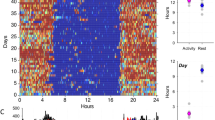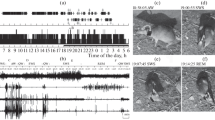The daily total sleep time (TST) of the only nocturnal simian primate, Aotus spp., remains little studied under controlled conditions. We conducted 3 experiments in 4 owl monkeys (Aotus sp.), aged 1–27+ yr, to determine the daily TST. We housed 3 their—a nuclear family—in 1 cage and the remaining senescent female in an adjacent separate cage. We monitored their activity-sleep pattern longitudinally for 15–20 d via actigraphy: by tagging an acclerometer-type miniature transmitter (Actiwatch-MINIMITTER) sensitive to omnidirectional movement, to the owl monkey's neck. The TST (9.5–12.5 h) was ca. 4.5–7 h less than the 17 h Perachio reported for owl monkeys in 1971 by polysomnography, under similar 12-h-light; 12-h dark conditions. Our finding corroborates well with the TST for other nonhuman primates. Four members of the Aotus colony at our facility reached 20 yr in captivity; the oldest (wild-born female) is still living at >27 yr, and the second oldest (captive-born male), is 23 years now.



Similar content being viewed by others
REFERENCES
Allman, J., Rosin, A., Kumar, R., and Hasenstaub, A. (1998). Parenting and survival in anthropoid primates; caretakers live longer. Proc. Natl. Acad. Sci. USA 95: 6866–6869.
Ancoli-Israel, S., Cole, R., Alessi, C., Chambers, M., Moorcroft, W., and Pollak, C. P. (2003). The role of actigraphy in the study of sleep and circadian rhythms. Sleep 26: 342–392.
Aquino, R., and Encarnacion, F. (1986). Characteristics and use of sleeping sites in Aotus (Cebidae: Primates) in the Amazon lowlands of Perú. Am. J. Primatol. 11: 319–331.
Baer, J. F. (1994). Husbandry and medical management of the owl monkey. In Baer, J. F., Weller, R. E., and Kakoma, I. (eds.), Aotus—The Owl Monkey. Academic Press, San Diego, pp. 133–164.
Baer, J. F., Weller, R. E., and Kakoma, I. (eds.) (1994). Aotus—The Owl Monkey. Academic Press, San Diego.
Bowden, D. M., and Jones, M. L. (1979). Aging research in non human primates. In Bowden, D. M. (ed.), Aging in Nonhuman Primates. Van Nostrand Reinhold, New York, pp. 1–13.
Campbell, S. S., and Tobler, I. (1984). Animal sleep; a review of sleep duration across phylogeny. Neurosci. Biobehav. Rev. 8: 269–300.
Carey, J. R., and Judge, D. S. (2000). Longevity Records: Life Spans of Mammals, Birds, Amphibians, Reptiles and Fish. Odense University Press, Odense (Internet version, nonpaginated; http://www.demogr.mpg.de/longevity records/)
De Boer, L. E. M. (1982). Karyological problems in breeding owl monkeys Aotus trivirgatus. Int. Zoo Year Book 22: 119–124.
Dement, W. C., and Vaughan, C. (1999). The Promise of Sleep. Delacorte Press, New York, pp. 241–259.
Dixson, A. F. (1982). Some observations on the reproductive physiology and behaviour of the owl monkey (Aotus trivirgatus) in captivity. Int. Zoo Year Book 22: 115–119.
Dixson, A. F. (1983). The owl monkey (Aotus trivirgatus). In Hearn, J. (ed.), Reproduction in New World Primates—New Models in Medical Science. MTP Press, Lancaster, UK, pp. 71–113.
Erkert, H. G. (1989). Lighting requirements of nocturnal primates in captivity: A chronobiological approach. Zoo Biol. 8: 171–191.
Erkert, H. G. (1999). Owl Monkeys. In Poole, T. (ed.), The UFAW Handbook on the Care and Management of Laboratory Animals, Vol. 1., 7th ed, Blackwell Science, Oxford, pp. 574–590.
Fernandez-Duque, E., and Rotundo, M. (2003). Field methods for capturing and marking Azarai night monkeys. Int. J. Primatol. 24: 1113–1120.
Ford, S. M. (1994). Taxonomy and distribution of the owl monkey. In Baer, J. F., Weller, R. E., and Kakoma, I. (eds.), Aotus—The Owl Monkey. Academic Press, San Diego, pp. 1–57.
Garcia, J. E., and Braza, F. (1993). Sleeping sites and lodge trees of the night monkey (Aotus azare) in Bolivia. Int. J. Primatol. 14: 467–477.
Giles, R. C. Jr., Hildebrandt, P. K., and Tate, C. (1974). Klebsiella air sacculitis in the owl monkey (Aotus trivirgatus). Lab Anim. Sci. 24: 610–616.
Groves, C. (2001). Primate Taxonomy. Smithsonian Institution Press, Washington DC, pp. 162–167.
Hayama, S. (1970). The saccus laryngis in Primates. J. Anthropol. Soc. Nippon 78: 274–298.
Hairston, I. S., and Knight, R. T. (2004). Sleep on it. Nature 430: 27–28.
Hearn, J. P., and Dixson, A. F. (1984). Assessment of comfort and well-being in New World primates. In The Universities Federation for Animal Welfare (UFAW), Standards in Laboratory Animal Management. Potters Bar, Hertfordshire, pp. 206–216.
Hershkovitz, P. (1983). Two new species of night monkeys, genus Aotus (Cebidae: Platyrrhini); a preliminary report on Aotus taxonomy. Am. J. Primatol. 4: 209–243.
Hewitt, G., MacLarnon, A., and Jones, K. E. (2002). The functions of laryngeal air sacs in primates; a new hypothesis. Folia Primatol. 73: 70–94.
Hill, W. C. O. (1964). Primates—Comparative Anatomy and Taxonomy, IV Cebidae Part A, Edinburgh University Press, Edinburgh, pp. 147–170.
Hill, W. C. O. (1972). Evolutionary Biology of the Primates. Academic Press, London, pp. 104–107.
Jones, M. L. (1962). Mammals in captivity-primate longevity. Lab.Primate Newslett. 1(3): 3–13.
Jones, M. L. (1982). Longevity of captive animals. Zool. Garten (Jena), 52: 113–128.
Kawamura, S., Takenaka, N., Hiramatsu, C., Hirai, M., and Takenaka, O. (2002). Y-chromosomal red-green opsin genes of nocturnal New World monkey. FEBS Lett. 530: 70–72.
Kushida, C. A., Chang, A., Gadkary, C., Guilleminault, C., Carrillo, O., and Dement, W. C. (2001). Comparison of actigraphic, polysomnographic, and subjective assessment of sleep parameters in sleep-disordered patients. Sleep Med. 2: 389–396.
Martin, R. D. (1987). Long night for owl monkeys. Nature 326: 639–640.
Melbin, M. (1978). Night as frontier. Am. Sociol. Rev. 43: 3–22.
Moynihan, M. (1964). Some behavior patterns of platyrrhine monkeys. I. The night monkeys (Aotus trivirgatus). Smithsonian Misc. Coll. 146(5): 1–84.
Perachio, A. A. (1971). Sleep in the nocturnal primate, Aotus trivirgatus. In Proceedings of the 3rd International Congress on Primates, Vol. 2. Karger, Basel, pp. 54–60.
Perachio, A. A. (1977). Vestibular functions and sleep in space experiments with nonhuman primates. In Simmonds, R. C., and Bourne, G. H. (eds.), The Use of Nonhuman Primates in Space. NASA Conference Publication 005, National Aeronautics and Space Administration, Ames Research Center, Moffett Field, California, pp. 179–195.
Rappold, I., and Erkert, H. G. (1994). Re-entrainment, phase-response and range of entrainment of circadian rhythms in owl monkeys (Aotus lemurinus g.) of different age. Biol. Rhythm Res. 25: 133–152.
Rathbun, G. B., and Gache, M. (1980). Ecological survey of the night monkey, Aotus trivirgatus, in Formosa province, Argentina. Primates 21: 211–219.
Sadeh, A., Hauri, P. J., Kripke, D. F., and Lavie, P. (1995). The role of actigraphy in the evaluation of sleep disorders. Sleep 18: 288–302.
Schultz, A. H. (1969). The Life of Primates. Weidenfeld and Nicholson, London, p. 150.
Scott, G. B. D. (1992). Comparative Primate Pathology. Oxford University Press, Oxford, p. 10.
Tattersall, I. (1987). Cathemeral activity in primates: a definition. Folia Primatol. 49: 200–202.
Wright, P. C. (1978). Home range, activity pattern and agonistic encounters of a group of night monkeys (Aotus trivirgatus) in Perú. Folia Primatol. 29: 43–55.
Wright, P. C. (1983). Day-active night monkeys (Aotus trivirgatus) in the Chaco of Paraguay. Am. J. Phys. Anthropol. 60: 272 (abstr.).
Wright, P. C. (1989). The nocturnal primate niche in the New World. J. Hum. Evol. 18: 635–658.
Wright, P. C. (1994). The behavior and ecology of the owl monkey. In Baer, J. F., Weller, R. E., and Kakoma, I. (eds.), Aotus—The Owl Monkey. Academic Press, San Diego, pp. 97–112.
Zepelin, H. (1989). Mammalian sleep. In Kryger, M. H., Roth, T., and Dement, W. C. (eds.), Principles and Practice of Sleep Medicine. W. B. Saunders, Philadelphia, pp. 30–49.
Zhdanova, I. V., Geiger, D. A., Schwagerl, A. L., Leclair, O. U., Killiany, R., Taylor, J. A., Rosene, D. L., Moss, M. B., and Madras, B. K. (2002). Melatonin promotes sleep in three species of diurnal nonhuman primates. Physiol. Behav. 75: 523–529.
ACKNOWLEDGMENTS
We thank Nobuko Matsubayashi of the Center for Human Evolutionary Modeling Research for providing expert technical assistance and Minoru Kinoshita for photography. Two anonymous referees provided much helpful criticism to improve an earlier version of the manuscript.
Author information
Authors and Affiliations
Corresponding author
Rights and permissions
About this article
Cite this article
Kantha, S.S., Suzuki, J. Sleep Profile and Longevity in Three Generations of a Family of Captive Bolivian Aotus . Int J Primatol 27, 779–790 (2006). https://doi.org/10.1007/s10764-006-9047-y
Received:
Revised:
Accepted:
Published:
Issue Date:
DOI: https://doi.org/10.1007/s10764-006-9047-y




